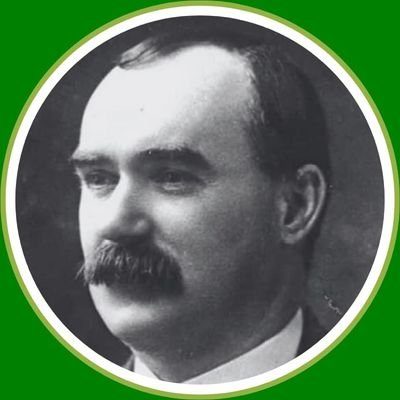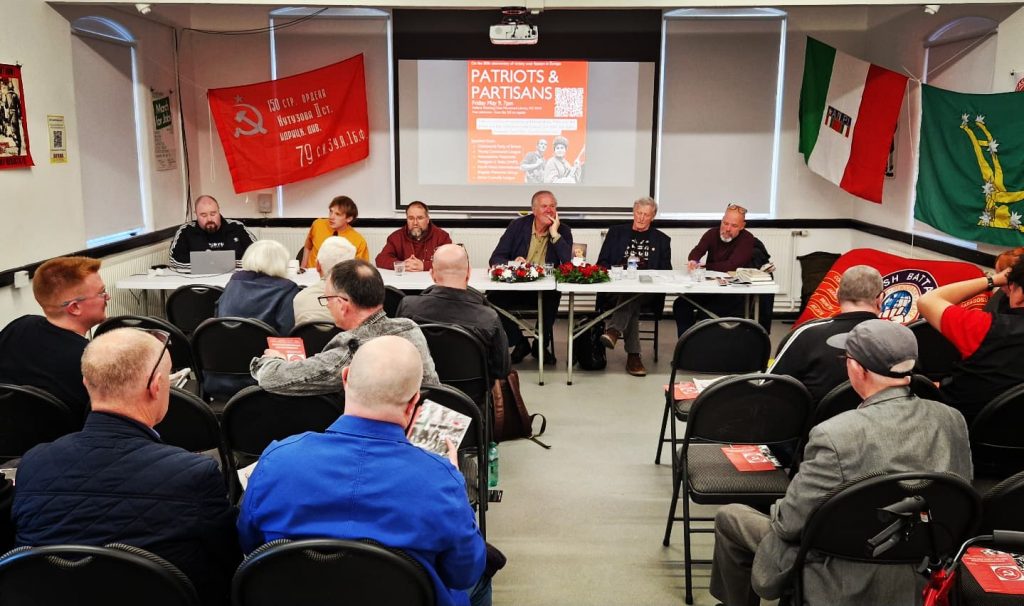
Remembering the Irish Connolly Column in the Spanish Civil War
In May 2025, members of the James Connolly League in north-west England supported an event in Salford, Greater Manchester, called Patriots & Partisans. It commemorated the 80th anniversary of the defeat of fascism in Europe in May 1945 and highlighted various anti-fascist resistance movements and forces throughout the 1920s, ’30 and ’40s. This included events, movements and forces in Ireland, Britain, Spain, Italy and the USSR.
Other organisations taking part included the International Brigade Memorial Trust, the Italian partisans’ association and anti-fascist network Associazione Nazionale Partigiani d’Italia (ANPI), the Communist Party of Britain and the Young Communist League.
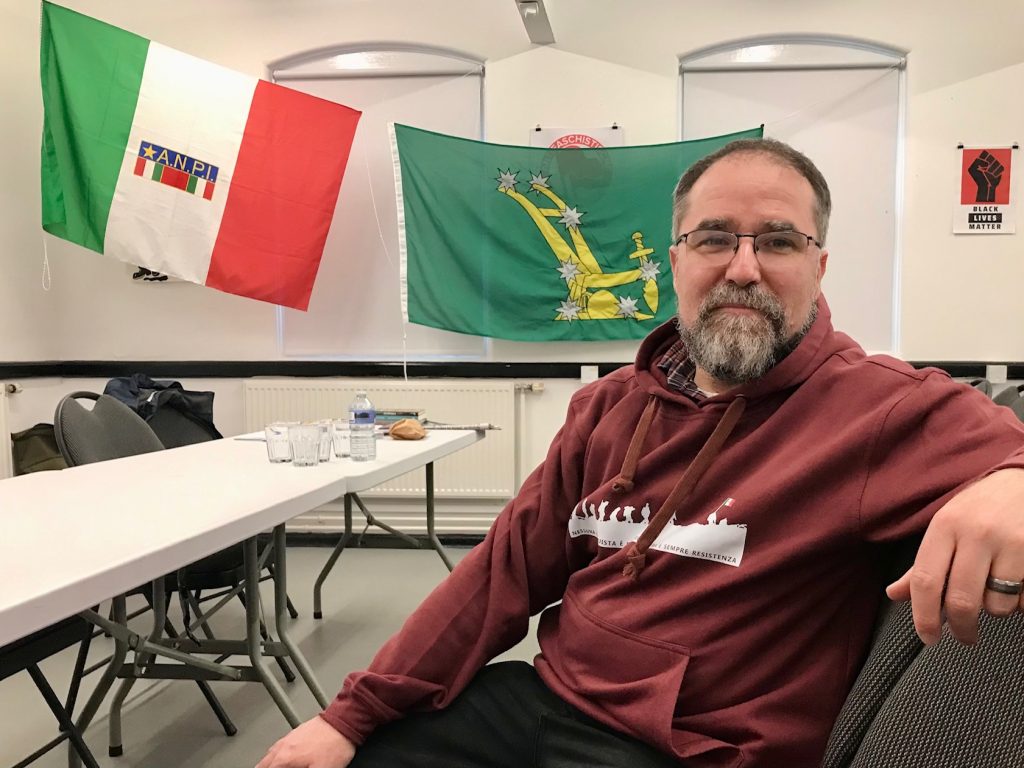
ABOVE: Simone Rossi, of ANPI, spoke about the rise of Mussolini and Italian fascism, and resistance against both the Italian fascist state and Nazi Germany. Partisans in Italy came from many nations.
Rob Hargreaves, one of the speakers pictured second from right in the top photo in this post, gave a talk about Irish radicals who fought as volunteers with the International Brigade against Spanish fascism during the 1930s Spanish Civil War. These Irish men were associated with the Connolly Column.
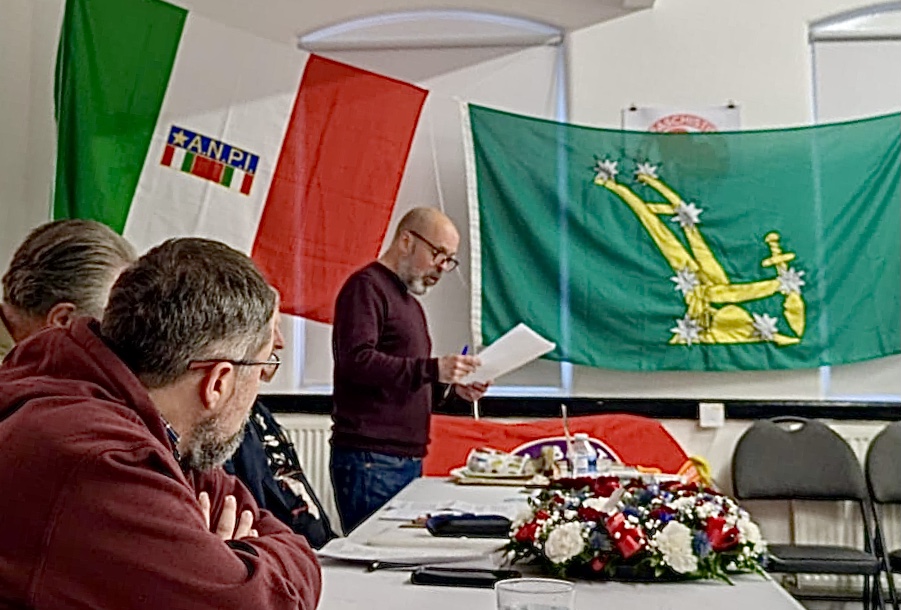
ANPI’s Italian flag and the Irish Starry Plough at the event, along with memorial wreaths for all who resisted fascism
Below is Rob’s speech given to Patriots & Partisans event in Salford:
“The Connolly Column was the name given to hundreds of
Irishmen who volunteered to fight in Spain for the democratic Spanish republic in the 1930s Spanish Civil War.
“They were named after James Connolly, the Irish socialist and one of the six Irish patriots executed by the British after the 1916 Easter Rising in Dublin. They fought bravely and many died. Subsequently, the term ‘Connolly Column’ came to be loosely applied to all Irish volunteers who fought for the Republic.
“Several groups on the left of Irish politics supported the
Spanish republic. But the government of the Irish Free State was
increasingly right-wing, supporting the Roman Catholic
Church and pro-Franco. In 1934 ex-IRA men who had fought
for Irish independence, formed the Republican Congress.
As socialists they were also motivated to join the
International Brigades by enmity towards the Irish
Blueshirts, a fascist group, led by Eoin O’Duffy, pictured below, also a
former IRA leader, who raised a force of 700 men to fight on
Franco’s side in Spain.
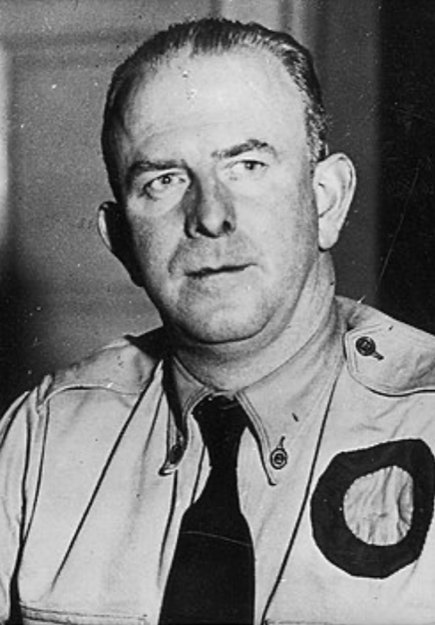
“Incidentally, a point of particular interest to Italian
comrades at this Patriots & Partisans talk, during Mussolini’s invasion of Ethiopia, O’Duffy had offered the services of a thousand Blueshirts; it seems. II Duce wisely declined the offer. In Spain the Blueshirts were so embarrassingly incompetent, that Franco sent
them home in June 1937. O’Duffy was the Irish version of
Oswald Mosley. They both had massive egos, which drove
them onto the wrong side of history.
“In the Spanish Civil War, comrades from all over Europe –
and beyond – fought bravely against the brutality of fascism and Francoism – a wickedness bolstered by the military
strength of Hitler and Mussolini.
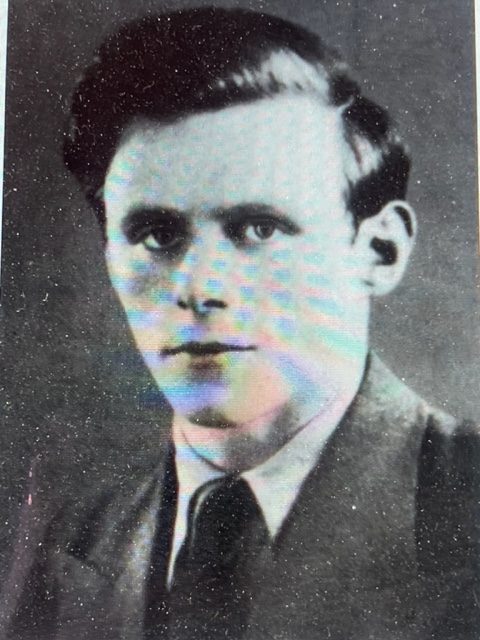
“Cut to the Battle of Jarama in February, 1937:
‘Even the olives are bleeding’. Spanish: HASTA LAS ACEITUNAS SANGRAN Italian: ANCHE LE OLIVE SANGUINAVANO
Irish: TA FIUNA OLOGA AG FUILIU
‘Even the olives are bleeding’. These were the last words of Irish Brigadista, and poet Charles ‘Charlie’ Donnelly, pictured above, one of the first Irishmen to fight in Spain. He died in the defence of Madrid. Few poets have uttered such memorable lines at the moment of death. (Donnelly is among a group of writers active in the Spanish Civil War remembered in this memorial in Spain, below)
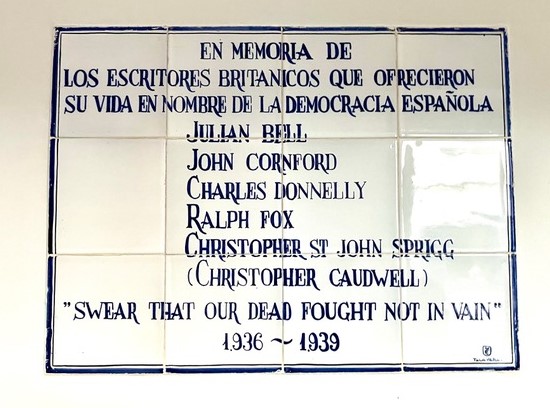
“Frank Ryan, pictured below, an IRA man who fought for independence, learned the Irish language and taught it, served as editor of the Republican journal An Phoblacht. He was a friend of
Donnelly and they were among the founders of the
Republican Congress.
“Ryan was the amongst the bravest and the most articulate
of International Brigaders. He was among those who rallied the British Battalion to a final, defiant defence against the fascists on
the crucial third day of the battle of Jarama. He was a
patriotic Irishman who put the need for unity against
fascism above narrow nationalism.
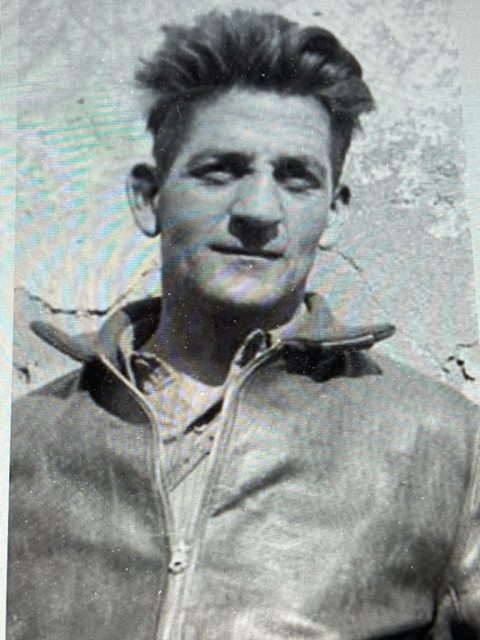
“When, at the the training base of the British Battalion, the
Irish contingent – about 80-strong – discovered that one of
their officers, George Nathan, had been a member of the
notorious Black-and-Tans, a British Army assassination
squad, Ryan – surely against a tide of personal emotion –
counselled against retaliation:
“He urged his fellow Irishmen, days before they went into
battle alongside English, Welsh and Scottish comrades, stating: “The
closest bonds of comradeship must unite us with all fighters against fascism. Rival national war cries will never be raised by us.”
“Irish volunteers, he added: “Have come to
Spain to break international fascism and, having broken it,
the freedom of our country will be more certain.’
“This took real courage: the Irish at Madrigueras were boiling
with rage over the fact that after the battle of Lopera, in
which they suffered heavy casualties, the Daily Worker newspaper report had omitted any mention of them. On top of that,
their well-meaning Spanish comrades referred to the Saklatava Battalion, the official name for the English-speaking battalion, comprising not only English, but Scottish, Welsh, and Cypriot volunteers as ‘La Brigada Inglese’.
“Many nationalities fought side-by-side as part of
the Fifteenth Brigade, the legendary Quinta Brigada.
“Ryan died, aged 41, in German captivity in 1944, after being taken prisoner in Spain in 1938. George Nathan, Jewish, and an able officer, whose ability had saved many lives in the early battles involving Irish
volunteers, was killed in action at Brunete in June, 1937.
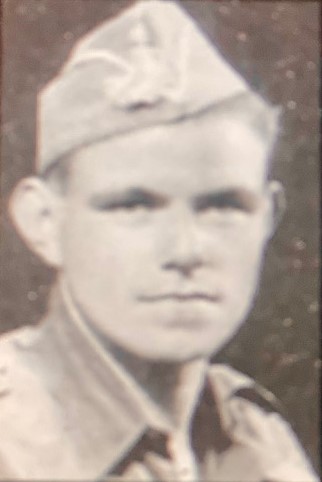
“Another well-known member of the Connolly Column was
Michael O’Riordan. In the final Spanish republican offensive,
O’Riordan, who had joined the Irish Communist Party,
carried the flag of Catalonia across the River Ebro and was
later seriously wounded. He, too, was a fervent Irish patriot,
who turned down a commission in the army of the Free
State to train IRA units in Cork.
“His son, Manus, became custodian of the history of the
Connolly Column. Not long before he died, I met him
and raised the issue of the ‘rebellious Irish’ at Madrigueras.
According to him, it was just the ‘awkward Liverpool Irish’
who were the trouble-makers.
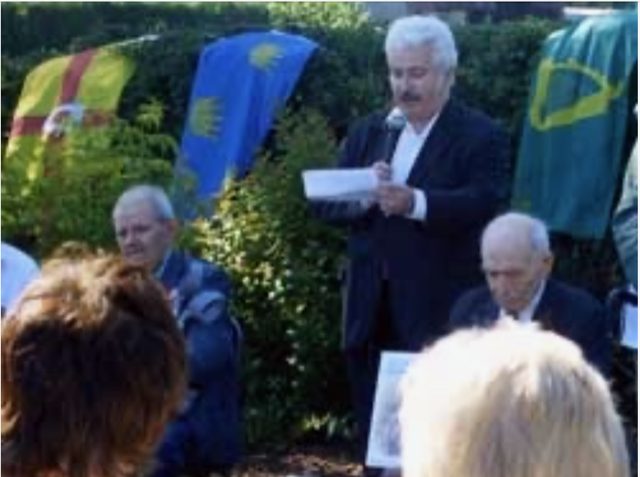
“Manus, pictured speaking here in 2005, at a memorial service to Irish Brigader Kit Conway, killed at Jarama, is pictured with his
father Michael, left, and surviving Brigader, Bob Doyle
right. Also killed at Jarama was protestant Church of
Ireland minister Bob Hilliard. Irish Brigaders came from both
sides of the religious divide, from the north and south,
from Belfast and Dublin.
“Michael O’Riordan estimated that 145 Irishmen fought in
Spain and that 61 never returned. His son’s message to me
was loud and clear: they were all Irish patriots and they
were all dedicated anti-fascists.
“During the recent commemoration of VE Day, some reports quoted Winston Churchill as saying that Britain was ‘the first to
take up the sword’ against the evil of fascism. In truth, the
first in the field were the volunteers from more than 50
countries including Ireland who fought with the International Brigades in Spain.”
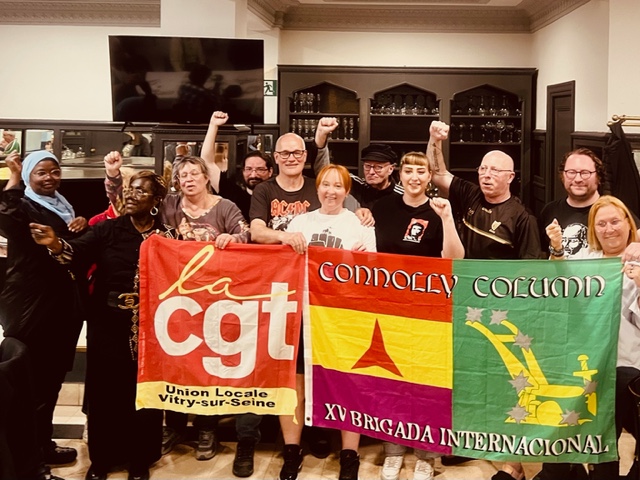
Remembering the Connolly Column at an event in Spain
Patriots & Partisans
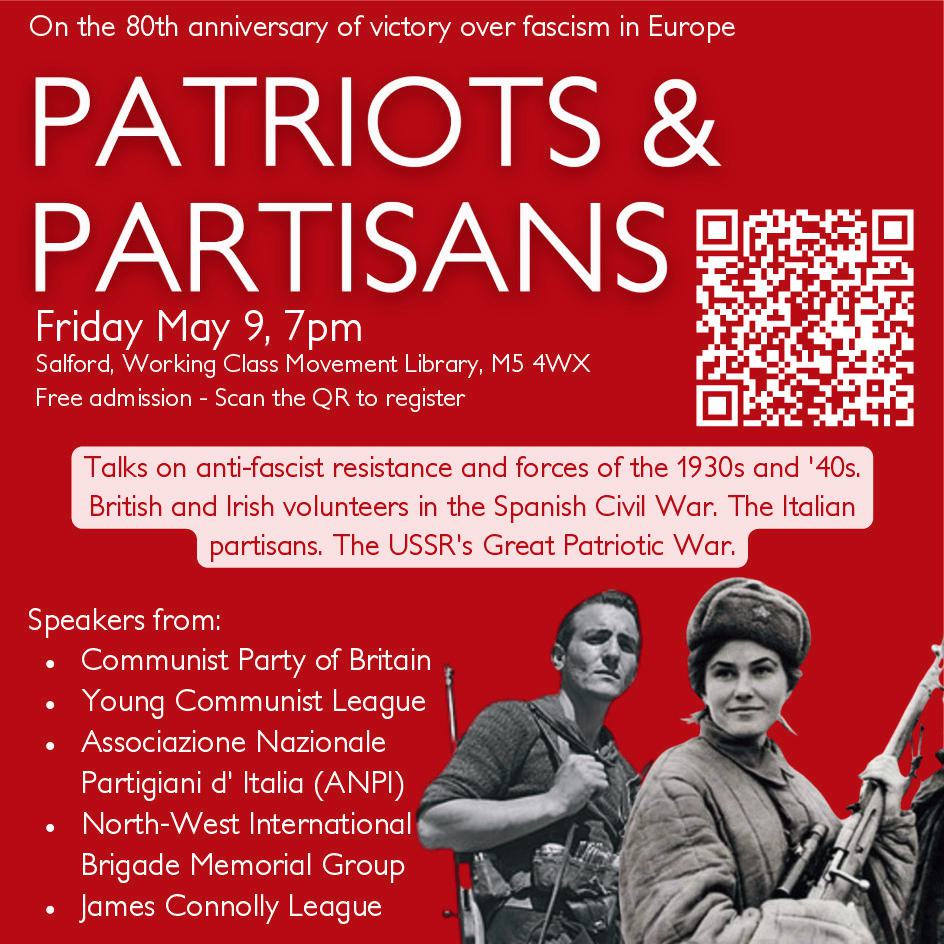
Join us for a special event on Friday, May 9, at the Working Class Movement Library, Salford, near Salford University. Patriots and Partisans. Hear about Irish anti-fascists in the Connolly League during the 1930s Spanish Civil War and other anti-fascist movements and forces of the 1920s, ’30s and ’40s. Ireland, Britain, Italy, Spain and the USSR. Reserve your free place on Eventbrite.
The Manchester Martyrs
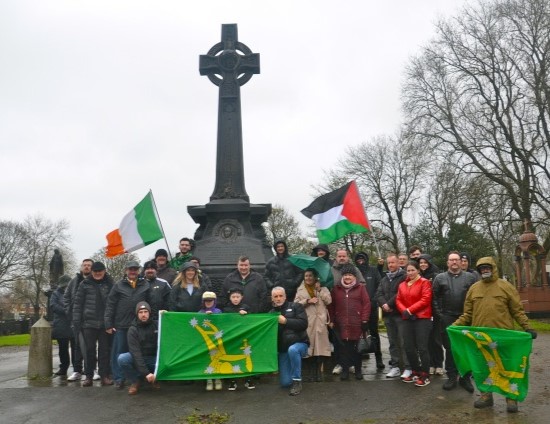
In November 2024, we supported the annual Manchester Martyrs commemoration in Moston, which was attended by groups from Britain and Ireland. The Manchester Martyrs Central Memorial Committee is the legal custodian of the memorial in Moston. Pictured below are two of the committee’s supporters. There are republican graves at the cemetery too.
The martyrs were William Philip Allen, Michael Larkin and Michael O’Brien who were members of the Irish Republican Brotherhood, also known as the Fenians.
Speakers highlighted the story of the martyrs, the values of the movements they belonged to and the relevance of these issues today. Also highlighted were global issues today including Palestinian and Middle East affairs.
Further events were held at the Irish Heritage Centre in Cheetham Hill. Manchester.
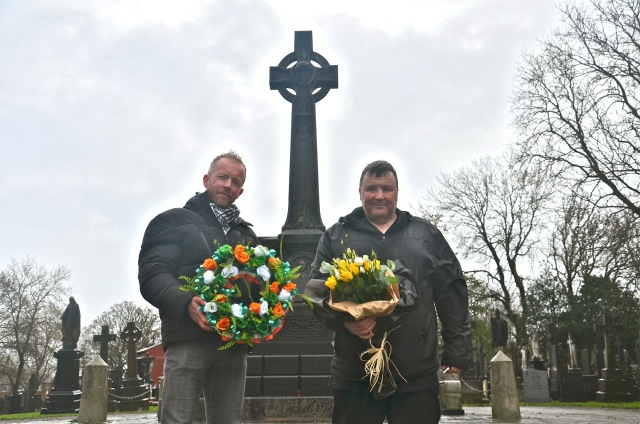
Look out for more updates
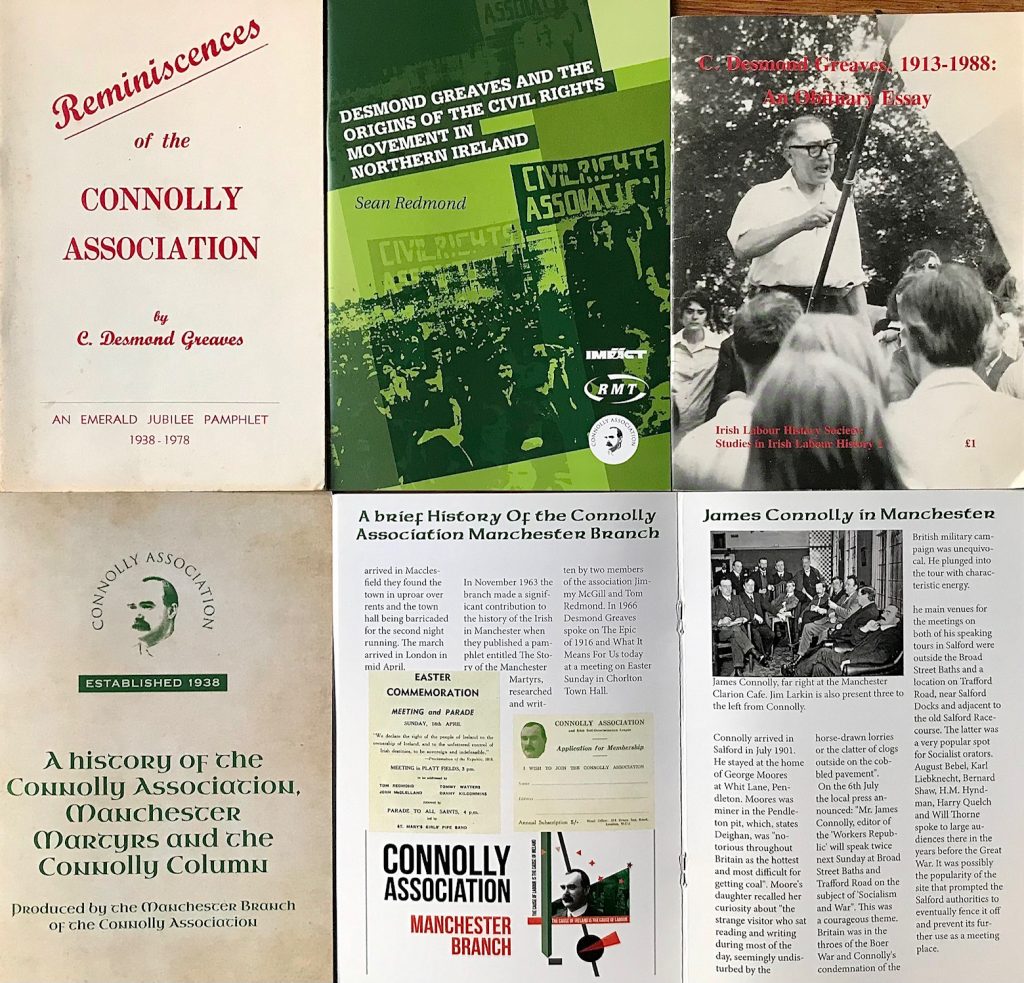
ABOVE: Old and more recent Connolly Association pamphlets. Our new James Connolly League builds upon the work and values of the former Connolly Association. See the About section in this website for more details.
